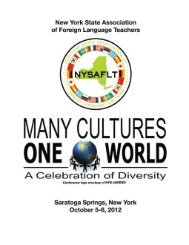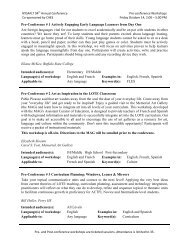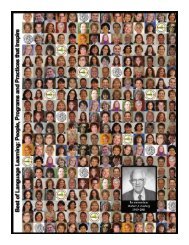THE COMPLETE CURRICULUM Ensuring a Place for the Arts and ...
THE COMPLETE CURRICULUM Ensuring a Place for the Arts and ...
THE COMPLETE CURRICULUM Ensuring a Place for the Arts and ...
- No tags were found...
You also want an ePaper? Increase the reach of your titles
YUMPU automatically turns print PDFs into web optimized ePapers that Google loves.
NASBE<strong>THE</strong> <strong>COMPLETE</strong> <strong>CURRICULUM</strong>Different Ways of KnowingDifferent Ways of Knowing (DOK), developed by <strong>the</strong>Galef Institute, is a school-wide initiative that integratesresearch from a number of sources on how children learn best.There are 10 “Different Ways of Knowing.” Below aredescriptions, as given by <strong>the</strong> Institute:1. Intelligence as expertise ra<strong>the</strong>r than fixed aptitude.In many schools across <strong>the</strong> country, intelligence has remained anarrowly defined set of literacy <strong>and</strong> ma<strong>the</strong>matical skills. In <strong>the</strong>past several decades, psychologists have explored <strong>the</strong> conceptof intelligence as <strong>the</strong> development of expertise. Thus, ef<strong>for</strong>t<strong>and</strong> persistence become relevant if intelligence is no longerviewed as a fixed aptitude.2. The arts as intelligences. If intelligence is <strong>the</strong> developmentof expertise, <strong>the</strong>n <strong>the</strong> development of artistic competence<strong>and</strong> expertise become valued as intelligences. Pedagogicalstructure is based on <strong>the</strong> growing body of research in <strong>the</strong>development of intelligences, <strong>the</strong> importance of <strong>the</strong> arts tohuman development, <strong>and</strong> mental representations.3. Exp<strong>and</strong>ing <strong>the</strong> literacy spectrum. A literate adult ableto develop a full life in <strong>the</strong> twenty-first century needs to learnmore than functional reading, writing, <strong>and</strong> math skills.Fur<strong>the</strong>r, if we value <strong>the</strong> arts as evidence of intelligence, <strong>the</strong>nstudents ought to have access to a robust curriculum in artsliteracy.4. Tapping prior knowledge. All learners approach novelsituations or new learning tasks with <strong>the</strong>ir rich knowledge base(intellectual, social, emotional, <strong>and</strong> practical knowledgedomains). Expert learners make connections to what <strong>the</strong>yalready know. When prior knowledge is tapped, <strong>the</strong> learner canbuild a meaningful <strong>and</strong> motivating bridge from <strong>the</strong> known to<strong>the</strong> unknown. Learners thrive in a safe, supportive environmentthat begins <strong>and</strong> builds on <strong>the</strong>ir strengths.5. Practicing habits of mind. Learners are curious.Learners are persistent. Learners strive <strong>for</strong> accuracy. Learnersnever stop learning. One line of inquiry leads to ano<strong>the</strong>r; this isone of <strong>the</strong> major underpinnings of <strong>the</strong> model. Learning eventsend not only with <strong>the</strong> question, “What did you learn?” but also“What will you learn next?”6. Project-based, real-life learning. Learners use <strong>the</strong>world as <strong>the</strong>ir laboratory. Real life does not present itself inisolated disciplines. Ra<strong>the</strong>r, life provides us with curiousmoments, unusual opportunities, interesting projects, <strong>and</strong>tough problems to solve. Real life requires knowledge <strong>and</strong>skills in <strong>and</strong> across disciplines. In real life, we learn new skillsfrom experts <strong>and</strong> we seek out those who know what we wantto learn. School-based learning can reflect this world-aslaboratoryparadigm.7. Collaboration <strong>and</strong> <strong>the</strong> social nature of learning.Learners learn best in collaboration with o<strong>the</strong>rs, when <strong>the</strong>y arenot isolated, but are part of a community of learners thatinvites dialogue, exchange, <strong>and</strong> project negotiations.8. St<strong>and</strong>ards-based planning, instruction <strong>and</strong> assessment.Planning matters. Educators benefit from planningroutines <strong>and</strong> protocols in which <strong>the</strong>y learn to bundle st<strong>and</strong>ardsin <strong>and</strong> across disciplines, plan multiple <strong>for</strong>ms of assessment, <strong>and</strong><strong>the</strong>n link <strong>the</strong>ir learning goals to big ideas, essential questions,<strong>and</strong> engaging learning events.9. Shared leadership in multiple ways around meaningfulissues. The Different Ways of Knowing distinction ofleadership is <strong>the</strong> capacity to create a future that o<strong>the</strong>rwise wouldnot exist <strong>and</strong> enrolling o<strong>the</strong>rs in that future. Everyone has accessto this distinction of leadership, <strong>and</strong> schools create multipleleadership groups, including parents, students <strong>and</strong> teachers.10. Breakthroughs in adult attitudes <strong>and</strong> practices asnecessary <strong>for</strong> st<strong>and</strong>ards-based practices to close <strong>the</strong>achievement gap. Educators <strong>and</strong> families of high schoolstudents need learning experiences <strong>and</strong> “uncommon” experienceswith students to challenge <strong>the</strong>ir implicit <strong>and</strong> deeply heldbeliefs in <strong>the</strong> bell-shaped curve <strong>and</strong> help <strong>the</strong>m to embrace <strong>the</strong>belief that all students can learn at high levels <strong>and</strong> developexpertise in single subjects. We at <strong>the</strong> Galef Institute alsobelieve in <strong>the</strong> integration <strong>and</strong> application of Howard Gardner’s<strong>the</strong>ory of multiple intelligences, which “unlock” <strong>and</strong> elevateadult expectations <strong>for</strong> students. The research on cognitivedevelopment representation supports <strong>the</strong> basic assumption of<strong>the</strong> st<strong>and</strong>ards movement: we should have high expectations <strong>for</strong>all students. However, as long as educators <strong>and</strong> families have anarrow view of what can <strong>and</strong> should take place in <strong>the</strong> highschool classroom <strong>and</strong> lack a vision—a mental picture—of whatstudents can accomplish, <strong>the</strong>re will be a gap between <strong>the</strong> policyof st<strong>and</strong>ards <strong>and</strong> <strong>the</strong> practice of st<strong>and</strong>ards.More in<strong>for</strong>mation about Different Ways of Knowing <strong>and</strong> <strong>the</strong>Galef Institute is available online at www.differentways.org.22






